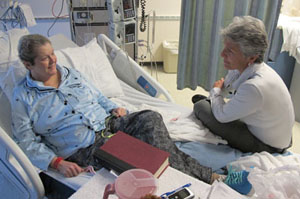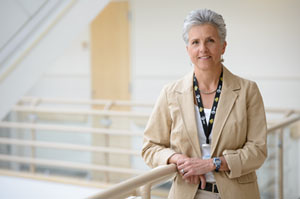Dr. Linda Smith walks into a room at Providence Alaska Medical Center, ready with a stethoscope and a huge grin. She teases her patient, Dawn Dillard, saying that her spiky hair recently resembled a “faux hawk.”
Dillard found out she had uterine cancer a year ago. Her oncologist gave her a year to live. The 57-year-old has beaten those odds, but now her kidneys are failing. After the laughs are over, Smith sits down on the edge of Dillard’s bed, leans in, and starts talking about a surgical procedure to help her kidneys.
Smith is a palliative care doctor, a specialty that is growing rapidly in the U.S. The idea is to help patients cope with a terminal or life-altering illness. And unlike hospice care, it is not offered only in the final months of life. Smith works on pain management, coordinating care and even does some counseling. Dillard, who is now in chemotherapy again, really appreciates it.
“I can’t even say how much she’s helped me,” Dillard says. “Just little things. You know, showing me things like breathing techniques. Sort of like mediation, just ways to focus on things that are positive and happy rather than focusing on your sickness and how crappy you feel.”
Becoming A Better Listener
Two years ago, Linda Smith was a very different kind of doctor.
She worked in the emergency room at the busy Anchorage hospital, where the goal was to quickly stabilize a patient and move on. But two decades into her career, she started to question how she was caring for patients at the very end of their lives. She remembers putting patients on breathing tubes and hearing family members say things like, “I know Dad didn’t want this, but we’re just not ready to let him go.”
“I started to have a lot of regret about doing things to people that were painful and uncomfortable and were prolonging their suffering,” Smith says. She thought, “if I only had the time to sit down with the family, I probably wouldn’t be doing these things.”
In 2011, Smith enrolled in a one-year palliative care fellowship at Providence. She had a lot to learn. She found out she was a bad listener. And she was abrupt. As an ER doctor, sometimes she was so busy she didn’t even sit down to deliver devastating news.
“I can remember saying to families things like, ‘I’m sorry, there’s nothing more I can do.’ And I realize now that sounds like abandonment to many people when you say you can’t do anything more. And the reality is I may not be able to do anything more to the patient that will make them survive, but there’s a lot more that I can do. I always can do more.”
Treatment Tradeoffs
A lot of what Smith does is talk to people. She doesn’t advocate for or against treatment, but she wants patients and their families to understand their decisions.
If a doctor puts in a breathing tube, for example, that may extend a patient’s life, but they won’t be able to eat or talk. If they die with a tube in, the family will miss hearing their last words. So now Smith sits down for hard conversations and looks patients and their family members right in the eye. Earlier this year, she was called in to consult with the wife of a patient who was dying.
“When I entered the room,” Smith says, “The wife said to me, ‘I know who you are.’ And I said, ‘Oh. OK.’ And she said, ‘I don’t want to talk with you and I don’t want to like you because you’re here to talk about death and dying, aren’t you?'”
Smith had a short conversation with the woman, and left her a book on difficult end of life choices. She went back to visit her the next day.
“And she said, ‘You know, I so tried not to like you. And what you had to say. And I really realize that we need to have this discussion now, don’t we?’
“And I said, ‘When you’re ready, we’re ready to have that discussion.’ And she said, ‘I’m ready now,'” Smith recalls.
There’s a shortage of doctors who provide palliative care, and the need is growing as baby boomers slide towards old age.
Smith was planning to go back to the emergency room. But interactions like that one persuaded her to stay in palliative care. Now she works more and makes less money. Some days, she wonders if she’s crazy.
But then she gets to visit a patient like Dawn Dillard.
Back in her hospital room, Dillard and Smith talk about having a second procedure. Smith leaves and calls Dillard’s other doctors. They end up agreeing that the second procedure isn’t really necessary after all. So instead of staying another night in the hospital, Dillard is back home by the end of the day.
This story is part of a reporting partnership that includes APRN, NPR and Kaiser Health News.








